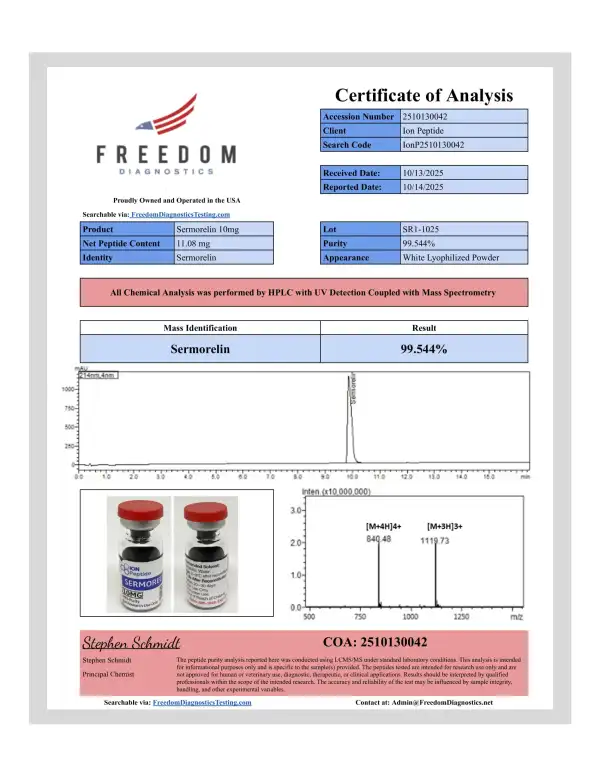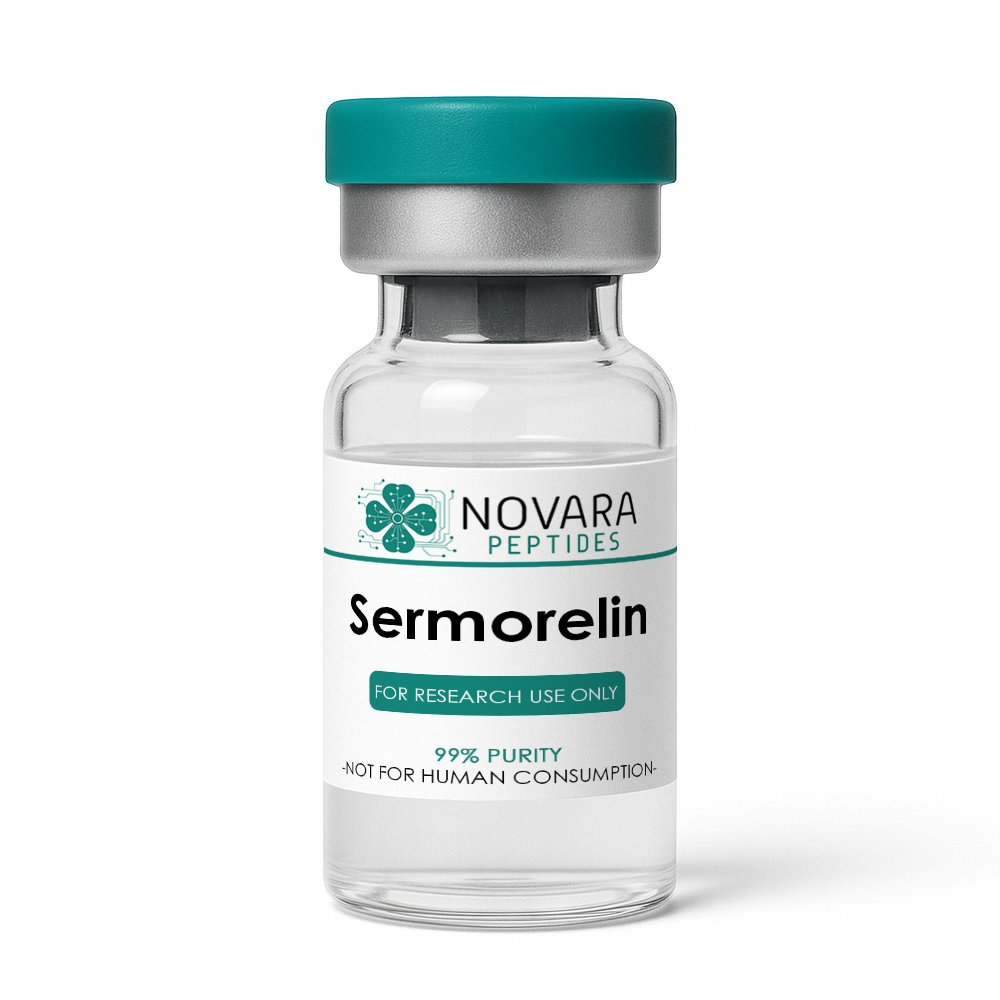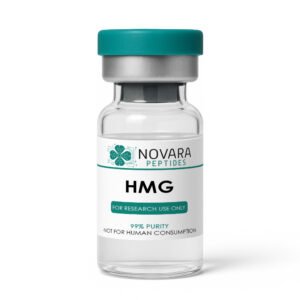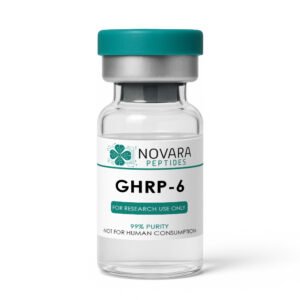Sermorelin – 10mg
$ 59.00
All products are for laboratory research purposes only. Not for human consumption, medical, or veterinary use. ION Peptides does not condone or support the use of peptides outside of controlled scientific research. By purchasing, you acknowledge that you are a qualified researcher or institution. You must be 21 or older.




Sermorelin (GRF 1-29)
Research-Grade GHRH Fragment
Tagline: Pulsatile GH Release Research
Product Description
Sermorelin (also known as GRF 1-29 or Sermorelin Acetate) is a synthetic peptide analogue of the first 29 amino acids of growth hormone-releasing hormone (GHRH) — the biologically active fragment responsible for stimulating GH secretion.
Researchers use Sermorelin to study pituitary GH secretion, IGF-1 production, and the regulation of the GH/IGF-1 axis. Its short half-life allows investigation of physiological, pulsatile GH release rather than continuous stimulation, making it a valuable tool in endocrine and metabolic research.
For Laboratory and Scientific Research Use Only. Not for Human Consumption.
Why Researchers Choose Sermorelin
Biologically Active GHRH Fragment: Mimics natural GHRH activity in the pituitary.
Supports Pulsatile GH Studies: Short half-life allows modeling of physiological GH secretion.
High Purity: ≥98% purity ensures reproducible and consistent results.
Reliable Research Tool: Extensively studied in endocrine and metabolic models.
Batch Verified: Identity, potency, and structural integrity confirmed for each lot.
Important Note
For laboratory and scientific research only. Not for human consumption, veterinary use, or diagnostic purposes.
| Chemical Formula | C₁₄₉H₂₄₆N₄₄O₄₂S |
| Molecular Mass | ~3357.9 Da |
| CAS Number | 86168-78-7 |
| Form | Lyophilized peptide powder (acetate salt) |
| Shelf Life | 24 months (lyophilized) |
| Intended Use | For preclinical and in vitro research only |
| Storage | -20 °C (dry powder), -80 °C (after reconstitution) |
Research Applications
GH/IGF-1 Axis Research
Sermorelin is commonly used to stimulate GH release and measure downstream IGF-1 production in preclinical and clinical studies [1].
Pulsatile GH Secretion Studies
Because of its short half-life, Sermorelin is ideal for modeling natural, pulsatile GH secretion rather than constant stimulation [2].
Metabolic Research
Increases lean body mass and reduces fat mass in animal studies through GH-mediated lipolysis and protein synthesis [3].
Endocrine Function Testing
Used in research to evaluate pituitary responsiveness to GHRH analogues [4].
Research
GH/IGF-1 Axis Studies
“Tesamorelin increases serum IGF-1 in HIV-infected patients” — Shown in studies of HIV patients with abdominal fat accumulation; daily 2 mg tesamorelin significantly increased IGF-1 (Week 26 etc.).
https://www.natap.org/2010/HIV/052810_03.htmVisceral Fat & Lipid Metabolism
“Effect of tesamorelin on visceral fat and liver fat in HIV-infected patients with abdominal fat accumulation: a randomized clinical trial” — JAMA 2014, Stanley TL et al. Reduced visceral adipose tissue & liver fat over 6 months versus placebo.
https://jamanetwork.com/journals/jama/fullarticle/1889139Body Composition Research
“Effects of Tesamorelin (TH9507), a Growth Hormone-Releasing Factor Analog, in HIV-infected Patients with Excess Abdominal Fat: A Pooled Analysis of Two Multicenter, Double-Blind Placebo-Controlled Phase 3 Trials with Safety Extension Data” — Falutz J et al. This includes effects on body composition (visceral fat, etc.).
https://academic.oup.com/jcem/article/95/9/4291/2835394Insulin Sensitivity & Metabolism
I did not find a clearly published, peer-reviewed full article that definitively proves “improvements in HOMA-IR / insulin sensitivity in non-HIV / general population with Tesamorelin” in my search. But there are some metabolic endpoints measured in the visceral fat / liver fat trial that touch on glucose / metabolic markers. For example, the JAMA trial (Stanley TL et al.) had secondary endpoints including glucose levels.
https://jamanetwork.com/journals/jama/fullarticle/1889139
Mechanism of Action (How Sermorelin Works)
GHRH Receptor Binding: Sermorelin binds selectively to GHRH receptors in the anterior pituitary, stimulating GH synthesis and release [Thorner 1983].
Physiologic GH Pulses: Short half-life allows for rapid clearance, resulting in pulsatile GH release similar to endogenous GHRH [Walker 1994].
IGF-1 Stimulation: GH secreted after Sermorelin administration increases hepatic IGF-1 production, supporting growth and metabolism research [Veldhuis 2001].
Lipolytic & Anabolic Effects: Through GH signaling, promotes fat breakdown and protein synthesis [Veldhuis 2001].
Endocrine Feedback Studies: Useful for examining hypothalamic-pituitary feedback loops [Laron 1988].
Research
GH/IGF-1 Axis Studies
“Tesamorelin increases serum IGF-1 in HIV-infected patients” — Shown in studies of HIV patients with abdominal fat accumulation; daily 2 mg tesamorelin significantly increased IGF-1 (Week 26 etc.).
https://www.natap.org/2010/HIV/052810_03.htmVisceral Fat & Lipid Metabolism
“Effect of tesamorelin on visceral fat and liver fat in HIV-infected patients with abdominal fat accumulation: a randomized clinical trial” — JAMA 2014, Stanley TL et al. Reduced visceral adipose tissue & liver fat over 6 months versus placebo.
https://jamanetwork.com/journals/jama/fullarticle/1889139Body Composition Research
“Effects of Tesamorelin (TH9507), a Growth Hormone-Releasing Factor Analog, in HIV-infected Patients with Excess Abdominal Fat: A Pooled Analysis of Two Multicenter, Double-Blind Placebo-Controlled Phase 3 Trials with Safety Extension Data” — Falutz J et al. This includes effects on body composition (visceral fat, etc.).
https://academic.oup.com/jcem/article/95/9/4291/2835394Insulin Sensitivity & Metabolism
I did not find a clearly published, peer-reviewed full article that definitively proves “improvements in HOMA-IR / insulin sensitivity in non-HIV / general population with Tesamorelin” in my search. But there are some metabolic endpoints measured in the visceral fat / liver fat trial that touch on glucose / metabolic markers. For example, the JAMA trial (Stanley TL et al.) had secondary endpoints including glucose levels.
https://jamanetwork.com/journals/jama/fullarticle/1889139

Related products
-
GHK-Cu
$ 29.00 – $ 58.00Price range: $ 29.00 through $ 58.00 Select options This product has multiple variants. The options may be chosen on the product page





